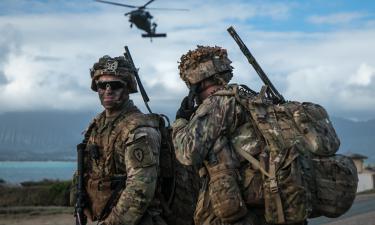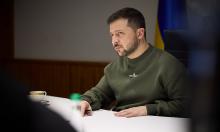Meeting the challenges of 4th generation warfare
 The United States, its allies, and coalition partners today find themselves at the apex threat of what is known as “Fourth Generation warfare.”
The United States, its allies, and coalition partners today find themselves at the apex threat of what is known as “Fourth Generation warfare.”
This difficult-to-circumscribe manifestation of human conflict is characterized by the inability to quantify, understand, and – ultimately – define the enemy. At the same time, many observers question or doubt the severity of the threat.
These issues further compound the critical need for military officials to develop operational plans that can effectively counter this threat. Fourth generation warfare has so matured in its asymmetric form that it now threatens the concept of democracy on the global stage. It is brutal, it is murderous, and it is real.
Al Qaeda’s employment on 9/11 of hijacked airliners against the World Trade Center towers, the Pentagon and (unsuccessfully) against either the White House or Capitol confirmed from that day forward that the orchestrators of fourth-generation warfare have a worldwide reach. Simply put, there is no longer a place to hide as attackers and ideologically motivated fanatics attempt to carry out suicide missions.
When the United States subsequently declared war on the al Qaeda network, our nation-state structure officially entered a new era of warfare.
Understanding the development of warfare over the centuries, is key to grasping the nature of the current threat.
The modern nation-state system - and the organized form of warfare that followed – was founded in 1648 when the Treaty of Westphalia concluded the Thirty Years War, also known as the war of religion. This covenant effectually granted, “the state” a monopoly on the use of organized violence leading to what analysts now call First Generation Warfare.
What followed, as technology came of age, was the classical nation-state form of fighting that culminated in the Napoleonic Wars. First Generation Warfare reflected the tactics of the era of the smoothbore musket and the use of the line and column in methodical advance. Synchronized drill and maneuver of dismounted forces generated a controlled, maximized, and predictable line of firepower and calculated yield.
Second Generation Warfare followed in response to the appearance of the rifled musket, breechloaders, battlefield obstacles such as barbed wire, the machine gun, and indirect fire through artillery. This covered the period in history that spans from the time of the American Civil War to World War I. This era of warfare was also known as the time of industrial war of attrition.
Then, in response to the increase in battlefield firepower through the use of aircraft, missiles and other technologies, the age of Third Generation Warfare emerged, defined at this point in history by intelligent, planned, and explotitational maneuver tactics, decision cycles on the battlefield, and the German blitzkreig.
The blitzkreig was based on maneuver rather than battlefield attrition. The weak industrial base in Germany after World War I required the development of new tactics. Germany understood that it could not win conflicts if they became solely a contest of war material.
We have now “matured” to Fourth Generation Warfare, which has changed everything. It pits nations against non-national organizations and networks that include not only fundamentalist extremists but ethnic groups, organized crime gangs and narco-traffickers as well. Its evolutionary roots may lie in guerrilla warfare, i.e. the Leninist theory of insurrection, and traditional terrorist tactics, but it is rendered more pervasive and effective by technology, mobility, and miniaturized instrumentalities, so ever-present by the age of computers and mass communication.
Fourth Generation Warfare allows the politically weak to easily circumvent the capacity of the state to protect itself through the traditional and time-tested use of conventional military systems and defenses. The new form of warfare embraces all forms of conflict while consciously ignoring the long developed “rules” of conflict and warfare.
To participants in Fourth Generation Warfare, there is no distinction between war and peace. There are no longer definable battlefields and fronts. As well, the obvious contrast between “military” and “civilian” virtually ceases to exist, as when Osama bin Laden issued a fatwa (religious decree) in 1998 ordering his followers to kill all Americans – soldiers and civilian men, women and children.
Countering this threat will require that the United States and its allies develop aggressive and controversial strategies for the global war on terrorism.
The ambiguities of Fourth Generation Warfare will also require dramatic changes in U.S. military capabilities (training, doctrine and weaponry). At the same time, established governments must dramatically change the approaches for safeguarding their national security.
This is a tall order indeed. No matter how many search-and-destroy missions we initiate against a fixed enemy site or location, and regardless of the number of terrorist operatives we target for assassination, suicide-bombers will continue to strike. They are, and will continue, to receive both overt and surreptitious support from rogue regimes led by our political and ideological adversaries. It is their intent to continue exacting violence on all symbols of established democratic societies, whenever and wherever they can.
Fourth Generation Warfare is a self-ingratiating and fulfilling fashion of ideological expression, not unlike an artistic creation, that, in a certain sense, it enables the self-proclaimed victims of oppression to transform their alleged oppressors into victims.
Even more incipient, this emerging population of fourth generation warriors gorges itself on the assets of its identified target of aggression. Our adversary ascribes to a methodology that unrestricted violence, free from any manifestation of pity or remorse as is contemporarily understood and accepted by the civilized world, is completely justified in the name of religious zeal expressed through murderous rage.
The conspirators who attacked New York and the Pentagon lived among their targeted victims. They patiently spent months honing their skills-in-trade at American pilot-training facilities. They drove American rental cars and they enjoyed pizza, beer and apple pie, all while preparing for their murderous transgressions.
This careful and protracted process of having infiltrated their targeted society elevated the perpetrators to heroes in many parts of the Middle East. Crowds on the West Bank, in Gaza and on the streets of Baghdad cheered the attacks.
The challenge that now confronts the world of nation-states is how to deal with this fundamental re-writing of the rules of war.
We need unorthodox thinkers and planners to plan a strategy that will lead to the destruction and elimination of this merciless and unrepentant foe.
In military terms, at the tactical level meeting the challenge demands the global coordination of intelligence. It calls for constant attacks, many of a clandestine nature, against Fourth Generation Warfare bases and cells. It will be absolutely necessary to sever the network lines that link the enemy cells. It will require the aggressive assassination of the extremists who serve as the intellectual control of and the resources for, the entities who protract this indiscriminate warfare.
That is a tall order indeed. But since the nation-state no longer holds a monopoly on militarily destructive forces, the civilized world must not limit itself in the act of self-preservation. This critical change to warfare requires that the traditional thought of sanctuary provided by national sovereignty is no longer sacrosanct, and it can no longer be honored.
J. David Galland,
Deputy Editor of DefenseWatch
DEFENSEWATCH02@yahoo.com
Subscribe to Pravda.Ru Telegram channel, Facebook, RSS!





